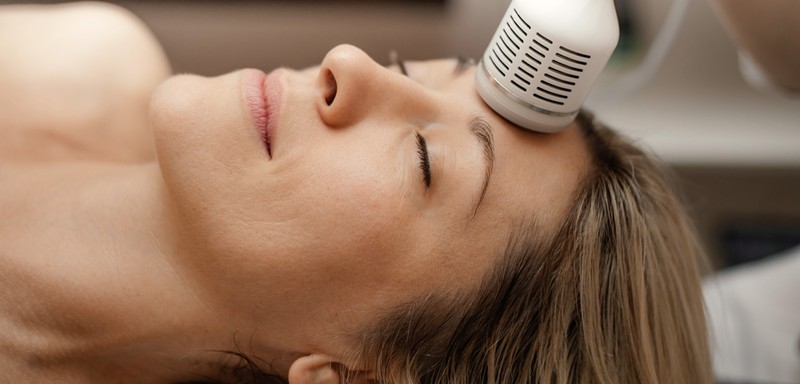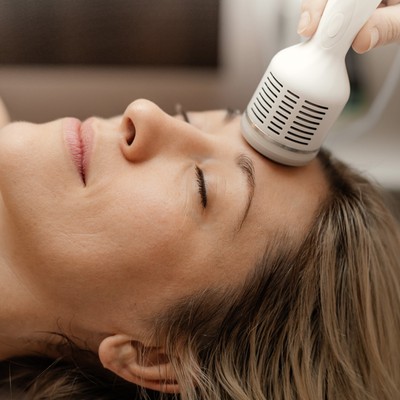

Everything You Need To Know About Ultrasound Facials
What Is An Ultrasound Facial?
“An ultrasound facial is a non-surgical treatment that uses focused ultrasound waves to lift and tighten the skin. During the treatment, a handheld device is glided against your face, emitting ultrasound waves beneath the skin’s surface. Some ultrasound devices – such as Ultherapy – have a scanning visualisation system, which allows accurate treatment of both the deeper skin layers called the SMAS (the layer surgeons manipulate when they do a facelift) and the dermal layers. The SMAS layer will thicken and tighten after the treatment, pulling the skin tissue above it taut and resulting in a lifted look. Devices such as Ultherapy can also target the dermis, where collagen is generated in the skin.” – Dr AJ Sturnham, GP specialising in dermatology
“The device used creates heat deep in the skin and underlying tissue. This heat stimulates collagen production and increases the overall regenerative activity in the area. This means more collagen and improved circulation, resulting in firmer, tighter skin. Long-term, having this type of treatment will slow down the overall ageing of your skin and maintain its elasticity.” – Debbie Thomas, celebrity facialist & skin specialist
Can You Run Us Through The Process?
“To begin with, your skin is cleansed; then we mark the areas that need to be treated. A cold water-based gel is applied, then the tip of the machine is placed on your skin. You will feel anything from a mild prickle to a sharper heat sensation for a second or two before we move the tip onto the next area, then repeat the process.” – Debbie
“Treatment time depends on the number of areas being treated, but typically you can expect it to last from 60 to 180 minutes.” – Dr AJ
To See Results, Should You Begin At A Certain Age?
“It’s mostly a treatment aimed at the over forties. This is because it works to tighten lax skin, so if your complexion is still very firm, you won’t see results as the skin can’t be pushed past its own natural condition. Those who are a bit older will see the most noticeable results – especially when it comes to lifting and tightening.” – Debbie
How Do Ultrasound Facials Compare To Botox & Fillers?
“Botox and fillers are types of injectable treatments that work in a completely different way to ultrasound facials. Botox is a neuropeptide that relaxes muscle contraction and so is used to reduce muscle movement and the appearance of dynamic lines in the frown area, forehead and crow's feet. Dermal fillers use a substance – typically hyaluronic acid – which is injected into the skin to restore lost volume and to add structural support within the skin. Ultrasound facials do not inject anything into the skin. They use a thermal energy to tighten connective tissue and to stimulate new collagen formation within the skin. Both injectables and ultrasound facials can be used side by side but, ultimately, it all depends on what you want to achieve.” – Dr AJ
Ultrasound Facials Are Non-Invasive, But Do They Still Involve Pain?
“The treatments can be comfortable to reasonably painful depending on the device being used. Ultrasound is the technology, but lots of brands have made machines using ultrasound – in other words, they all feel different. A newer version of ultrasound is HIFU – High Intensity Focused Ultrasound. This tends to be less painful as the waves are focused precisely into the deeper layers of skin. This is where it has the most benefit, but also where there are fewer nerve endings to be pinged by zaps of energy and heat. For me, this is the best option and the most precise. We use it in my clinic and we are seeing great results. Our clients find it to be very tolerable, too.” – Debbie
“The manufacturers will tell you that these treatments do not hurt but in practice they do. At my clinic we follow a medical protocol to ensure that the treatment is more comfortable, which includes using strong numbing cream and oral analgesia. Both are always an option if you feel you need it.” – Dr AJ
HIFU Aside, Are There Any Other Ultrasound Options To Know?
“Ultherapy is my go-to ultrasound facial – it’s FDA-approved for lifting the skin on the jowls, neck and the eye area. It uses much more accurate microfocused ultrasound (MFU) waves which are guided by a visualisation system so that the practitioner accurately delivers the energy to the precise locations in the skin that they need to. It’s great for tightening the neck and jawline but this can be used to treat the whole face, and also to create a brow lift. Most patients will do this once a year. There’s also the Focus Dual which uses HIFU and radiofrequency microneedling. The combination of these two technologies means the upper and lower dermal layers are targeted for speedy results. Finally, there is Ultracel. This merges radiofrequency and HIFU together. It has no visualisation unit, which is why I personally do not offer these treatments, as I feel that this aids the safety of the treatment. However, the manufacturer advises that the exact depths of treatment are precisely calibrated to ensure that the treatment is safe and effective. There are so many options available, and your practitioner will always discuss the best one for you prior to going forward.” – Dr AJ
Can Everyone Try Ultrasound Facials?
“Most people are eligible and can benefit, but some medical conditions or medications could make it unsuitable. We always prescribe a treatment on a case-by-case basis and go from there – any good practitioner will do this. That said, we find ultrasound is popular across the board, with all skin colours and all sexes.” – Debbie
“If you have a pacemaker or any metal implants in your body, ultrasound facials may not be for you. This is because ultrasound is often combined with radiofrequency and this can have an impact. Your doctor will assess you first and always guide you through what’s best for you – don’t be afraid to ask questions either.” – Dr AJ
As For Results, How Long Do They Last Post-Treatment?
“Once the initial treatment has been performed, it can take a further six months to see the final results. These will then last over a year; however, we recommend a top-up session every six to nine months for overall maintenance.” – Debbie
“While many patients feel there is a degree of instant tightening, the true benefits will begin to show after three months of your first session. The best bit is this continues to improve as time goes on. Results from HIFU and MFU can last for up to two years.” – Dr AJ
Finally, How Much Do Ultrasound Facials Cost?
“Ultherapy is £3,000 for the face and neck at my Nuriss clinic in London, but clinics decide their own fees. Some places may even charge up to £7,000 for the same areas – it’s why it pays to do your research, but always question those that are overly cheap. While these facials are expensive, it’s worth seeing them as an investment; they are fairly quick and most only require one treatment per year, too. My best advice is to find a doctor-led clinic and one that uses FDA-approved devices. Always book a consultation before you commit to anything.” – Dr AJ
Where To Try Ultrasound Facials
DISCLAIMER: We endeavour to always credit the correct original source of every image we use. If you think a credit may be incorrect, please contact us at info@sheerluxe.com.

